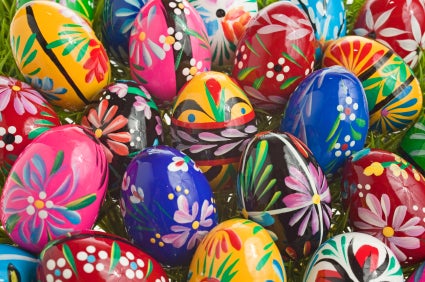Ukranian Pysanky Easter Eggs
What came first: the Easter or the egg? While today we decorate eggs to celebrate the colorful return of springtime that coincides with Easter, it wasn’t always so. Long before Christianity and the widespread acceptance of its holidays, people were decorating eggs – especially in the Ukraine. Ukrainian eggs, known as pysanky, are traditionally decorated in the batik style, which is when hot wax is put onto the egg’s shell with a needle-like tool. After the wax is applied in the desired pattern, the egg is submerged in dye (just like we do for our Easter ova). This process is then usually repeated to create elaborate patterns.

Since eggs aren’t exactly made of iron, they don’t hold up so well against centuries of erosion, pollution, and natural catastrophes, resulting in a lack of ancient examples of these decorative eggs. However, the Ukrainians also practiced their skills on stone, clay, and bone eggs, which can be dated back to the 5th or 3rd century BCE. The oldest true pysanka was discovered in 2008 and can be dated back to the 17th century, which is pretty amazing given how fragile they are.
Like many people, the ancient Ukrainians worshiped a sun god, which they called Dazhboh. Since birds could fly nearest to the sun, their god, the creatures were thought to be of his creation, and thus, the eggs were magical objects, as well as a source of life. That’s why they were treated so delicately and served as talisman – especially those made from rooster and chicken eggs.
These special eggs are the starting point for a good deal of Ukrainian traditions and folklore. According to the Hutsuls, a people who have inhabited the Carpathian Mountains for centuries, believe that pysanky determines the fate of the world. Unless you want to unleash a giant evil serpent-creature, you’d better start getting your dye on. According to lore, as long as the egg custom continues, the world will carry on. Each year, the serpent sends out his minions to see how the eggs are coming along and if the number is low, the evil creature is set free to cause havoc…so keep the eggs coming.
As they have been for thousands of years, today’s pysanky are made as gifts. Usually given to family members and respectable people, these eggs are covered with designs meant to represent who they’re gifted to. While some are decorated with plant and animal motifs, the most popular designs are geometric, with the egg divided into triangles and squares that are then filled with other symbols. Of course, each symbol has a meaning. A diamond, for example, represents knowledge, curls offer protection, and waves symbolize great wealth.
Want to take your Easter eggs to the next level this year? It’s easily done. There are plenty of kits and books available to teach you the art of pysanky, but don’t expect yours to be perfect right away. This art form has been around for thousands of years and design patterns have been practiced in families – handed down from mother to daughter – for generations, enriching all cultures with an amazing art…and possibly protecting the world from a giant snake.